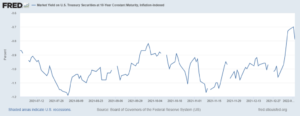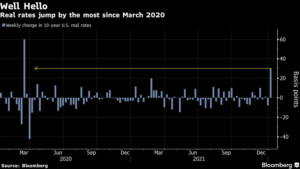We typically think of interest rates at their surface level or simply as the rate posted on a CD or treasury bond. Economists and professional investors will commonly refer to these as nominal rates. But real interest rates, or the nominal interest rate after inflation is subtracted, are what really matter. Because the inflation rate whips around from month to month, looking at real rates in this manner, while useful and necessary, can be too volatile for real-time insight into how the market is pricing real interest rates.
Rather than deriving real rates as described in the opening paragraph, we have a convenient and effective tool for measuring the market-priced real rate at any time. We need to look at Treasury Inflation-Protected Securities (TIPS) yield. Because these bonds adjust for inflation, the yield on these bonds reflects the market's prevailing real rate. For all the talk in the second half of 2021 of the Fed raising rates (of which they are now very clearly set on doing multiple times this year), markets entered 2022 with real interest rates stubbornly in negative territory. They did attempt a return to positive territory early in 2021 when the economy appeared to be on a straight line back to “normal” but returned to and remained much closer to -1% than they did 0 for the remainder of the year.

The interpretation and implications of this phenomenon warrant emphasis. The implications are that investors who were purchasing these bonds were accepting a locked-in (assuming they don't later sell) real return of ~-1% per annum on their investment. In other words, $10,000 invested at those recent rates would have a purchasing power of ~$9,000 …..10 years from now!
2022 has started with a bang, bringing the sharpest weekly change since March of 2020 (recouping the apocalyptic drop at the beginning of the pandemic).

This change is so significant because of what may be a turning point in rates and what it has spurred in market reactions. Market participants have clearly been underappreciating what a return to anything like normal real rates looks like. One aspect of this underappreciation is the possibility that stocks and bonds move more closely in the months or years ahead than they have for much of the past few decades. Correlating more closely (having their below-average weeks or months at the same time) has the potential for increased risk at the same time return outlooks are diminished.
That doesn't mean this trend has to continue, but its possibility warrants the utmost respect. As such, portfolio construction needs to be made with this in mind. Inflation rates have now surpassed levels for long enough to have the Fed's full attention. Their recent meeting notes make that much clear. Whether it's due to temporarily reduced supply capabilities or rapidly expanded money supply doesn't really matter. A significant side effect of this shift in policy is a strong possibility that real rates find their way back to positive territory. This, as it should be, is the Oz behind the curtain for the time being.
The Financial Enhancement Group is an SEC Registered Investment Advisor. Securities offered through World Equity Group, Inc. Member FINRA/SIPC. Advisory services can be provided by Financial Enhancement Group (FEG) or World Equity Group. FEG and World Equity Group are separately owned and operated.


